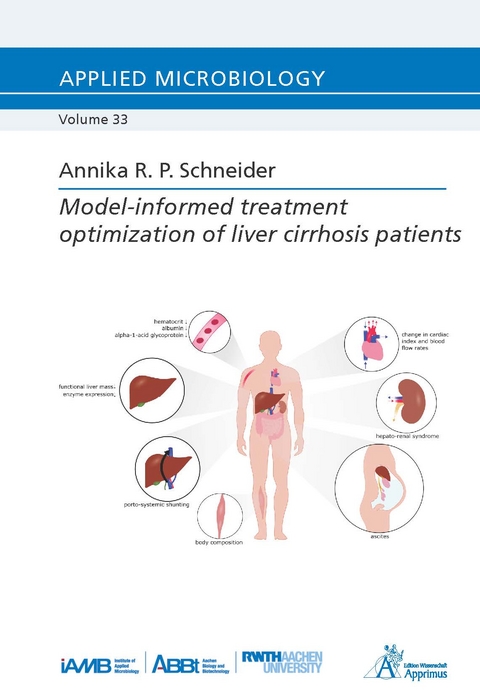Model-informed treatment optimization of liver cirrhosis patients
Seiten
2024
Apprimus Verlag
978-3-98555-202-3 (ISBN)
Apprimus Verlag
978-3-98555-202-3 (ISBN)
The life expectancy of liver cirrhosis patients drastically worsens with decompensation. In this work, a clinical score was developed to identify patients at high risk for decompensation enabling targeted treatment. Furthermore, to facilitate treatment and drug development for liver cirrhosis patients, a PBPK framework for liver cirrhosis was developed. The presented work provides two tools for treatment optimization of liver cirrhosis patients potentially improving patient health in the future.
Liver cirrhosis is accompanied by a variety of severe complications that drastically reduce patients' life expectancy. The aim of this study was to improve therapeutical interventions for liver cirrhosis patients by identifying patients with a high need for treatment and by characterizing the pathophysiological changes in cirrhosis patients to facilitate drug development and pharmacotherapy.A hallmark of disease progression in liver cirrhosis is the transition from a compensated to a decompensated state. While patients are mostly asymptomatic in the compensated state, the decompensated stage is characterized by the presence of severe symptoms. Consequently, decompensation is associated with a sharp drop in life expectancy. In this study, a prognostic clinical score, the Early Prediction Of Decompensation (EPOD) score, was developed to identify liver cirrhosis patients at high risk of decompensation. This enables targeted monitoring and targeted therapeutic interventions to delay or even prevent decompensation and potentially extend life expectancy. In general, pharmacological treatment of liver cirrhosis patients is challenging. The pathophysiological changes associated with liver cirrhosis may impact the pharmacokinetics of drugs putting patients at high risk for adverse drug reactions. In this work, pathophysiological changes for 30 physiological parameters were quantified dependent on the disease stage. To account for the complexity of the interplay of these parameters and estimate their combined impact on drug pharmacokinetics, these parameter quantifications were embedded into a physiologically based pharmacokinetic modeling framework. For this purpose, virtual populations were generated, and disease-related modifications were applied to the organism physiology. The ensuing simulations of the pharmacokinetics of several drugs in cirrhosis patients revealed good predictive performance of the approach. The presented work provides two tools for treatment optimization of liver cirrhosis patients: (1) a clinical score for identifying patients at high risk for decompensation that need intervention and (2) a modeling approach for predicting changes in pharmacokinetics in liver cirrhosis patients that may help for dosing decisions and support the approval of medications for liver cirrhosis patients. In summary, this work contributes to the improvement of treatment of liver cirrhosis patients, thus, potentially improving patient health and life expectancy.
Liver cirrhosis is accompanied by a variety of severe complications that drastically reduce patients' life expectancy. The aim of this study was to improve therapeutical interventions for liver cirrhosis patients by identifying patients with a high need for treatment and by characterizing the pathophysiological changes in cirrhosis patients to facilitate drug development and pharmacotherapy.A hallmark of disease progression in liver cirrhosis is the transition from a compensated to a decompensated state. While patients are mostly asymptomatic in the compensated state, the decompensated stage is characterized by the presence of severe symptoms. Consequently, decompensation is associated with a sharp drop in life expectancy. In this study, a prognostic clinical score, the Early Prediction Of Decompensation (EPOD) score, was developed to identify liver cirrhosis patients at high risk of decompensation. This enables targeted monitoring and targeted therapeutic interventions to delay or even prevent decompensation and potentially extend life expectancy. In general, pharmacological treatment of liver cirrhosis patients is challenging. The pathophysiological changes associated with liver cirrhosis may impact the pharmacokinetics of drugs putting patients at high risk for adverse drug reactions. In this work, pathophysiological changes for 30 physiological parameters were quantified dependent on the disease stage. To account for the complexity of the interplay of these parameters and estimate their combined impact on drug pharmacokinetics, these parameter quantifications were embedded into a physiologically based pharmacokinetic modeling framework. For this purpose, virtual populations were generated, and disease-related modifications were applied to the organism physiology. The ensuing simulations of the pharmacokinetics of several drugs in cirrhosis patients revealed good predictive performance of the approach. The presented work provides two tools for treatment optimization of liver cirrhosis patients: (1) a clinical score for identifying patients at high risk for decompensation that need intervention and (2) a modeling approach for predicting changes in pharmacokinetics in liver cirrhosis patients that may help for dosing decisions and support the approval of medications for liver cirrhosis patients. In summary, this work contributes to the improvement of treatment of liver cirrhosis patients, thus, potentially improving patient health and life expectancy.
| Erscheint lt. Verlag | 14.2.2024 |
|---|---|
| Reihe/Serie | Applied Microbiology ; 33 |
| Verlagsort | Aachen |
| Sprache | englisch |
| Maße | 148 x 210 mm |
| Gewicht | 299 g |
| Themenwelt | Naturwissenschaften ► Biologie ► Mikrobiologie / Immunologie |
| Schlagworte | Leberzirrhose • Microbiology • Mikrobiologie |
| ISBN-10 | 3-98555-202-9 / 3985552029 |
| ISBN-13 | 978-3-98555-202-3 / 9783985552023 |
| Zustand | Neuware |
| Haben Sie eine Frage zum Produkt? |
Mehr entdecken
aus dem Bereich
aus dem Bereich
Allgemeine Grundlagen und spezielle Anwendungen
Buch | Softcover (2021)
Springer Berlin (Verlag)
CHF 76,95




